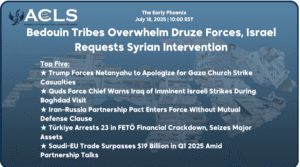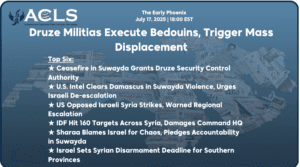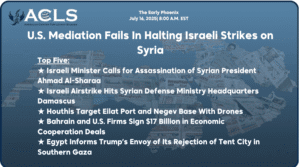The Region October 30-2023
Executive Summary:
The Middle East remains a volatile geopolitical landscape, with escalating tensions and complexities since last week’s analysis. Israel’s domestic and international scrutiny is intensifying due to the worsening humanitarian crisis in Gaza. Iran is increasingly assertive, challenging Western alliances and indicating readiness for escalated conflict. Saudi Arabia continues its focus on economic strategy, while the broader Gulf region amplifies calls for a Gaza ceasefire. Iraq is aligning more closely with Iran, challenging U.S. interests in the region. Syria sees escalating military activities involving U.S. forces and Iranian-backed militias. Egypt’s confrontational stance against Israel marks a significant shift in regional dynamics. Lebanon faces internal divisions and an assertive Israeli stance, while Turkiye’s deteriorating relations with Israel could significantly alter the geopolitical landscape. Overall, the region is marked by shifting alliances, escalating conflicts, and a challenging environment for U.S. policy. The unfolding events signal a tectonic shift in regional alliances and conflicts, making it imperative to delve into this week’s Deep Dive Analysis for a nuanced understanding of the rapidly evolving Middle East landscape.
===========================
The Region October 30-2023
ISRAEL & PALESTINIAN TERRITORIES
- Global Reverberations, Volatile War, and Diplomatic Strains. The situation in Israel and Gaza is complex and multi-faceted, involving not just military actions but also diplomatic efforts, public opinion, and international law. The Israeli army’s intensified ground operations in northern Gaza have led to large-scale displacement and a high civilian death toll. This has prompted international calls for an immediate ceasefire, including from UN Secretary-General António Guterres and US President Joe Biden. However, Israel’s Prime Minister Netanyahu has been under domestic scrutiny for his handling of the situation, particularly after blaming intelligence chiefs for a failure to anticipate a Hamas attack, a statement he later retracted. Diplomatic efforts to de-escalate the conflict are underway, involving multiple countries including Saudi Arabia, Iran, France, and the UK. Interestingly, Russia has been involved in negotiating the release of Russian-Israeli hostages taken by Hamas, indicating the group’s willingness to engage in diplomatic efforts with certain states. Meanwhile, tensions between Hezbollah and Israel have escalated, adding another layer of complexity to the regional dynamics. Israel is also advancing its counterterrorism legislation, allowing for the designation of individuals as terror operatives. This could have far-reaching implications for how Israel engages with those it considers to be threats. On the technological front, Elon Musk‘s offer to provide Starlink Internet to Gaza has raised concerns about the potential misuse of this service by Hamas, further complicating international involvement in the crisis. The humanitarian situation in Gaza is dire. Despite the largest aid shipment to date, needs far outstrip supply. The Israeli military continues its offensive, targeting militant positions, but also disrupting essential services like internet and phone connectivity. Hamas has indicated its readiness for a prisoner exchange, but it’s unclear how this aligns with Israel’s strategic objectives, which include a large-scale ground offensive aimed at destroying Hamas’ capabilities. The extensive network of tunnels in Gaza, built by Hamas, poses a significant challenge for any ground offensive by Israel. These tunnels are crucial for Hamas’ military operations and their existence complicates any efforts to bring about a swift end to the conflict. The UN General Assembly‘s call for an immediate ceasefire, which Israel has rejected, underscores the international community’s concern over the humanitarian crisis. However, the resolution’s omission of Hamas has drawn criticism, highlighting the complexities involved in achieving a balanced international response. In summary, the situation involves multiple actors, each with their own set of interests and strategies, making it a highly volatile and complex crisis. The involvement of various countries in diplomatic efforts, the changing dynamics of military engagement, the dire humanitarian situation, and the domestic pressures faced by leaders like Netanyahu all contribute to a situation that is fluid and fraught with challenges.
===========================
The Region October 30-2023
IRAN
- Iran Defies West: Increasingly Empowered as Escalated Conflict Is Palpable. Starting with Iran’s bold defiance tests U.S. and allies in the Gaza-Israel conflict encapsulates Iran’s increasingly assertive role in regional politics. Tehran is unified in dismissing Western efforts to curb its influence, particularly evident in its stance on the Gaza-Israel conflict. Furthermore, Germany‘s IRGC dilemma: a question of commitment to Israel’s security raises serious questions about the solidity of Western alliances, as Germany hesitates to take firm action against the IRGC, thereby clouding its commitment to Israeli security. Additionally, IRGC chief warns Israel: dire consequences await Gaza invasion serves as an extension of Iran’s confidence, as it implies readiness for an escalated conflict while vouching for Hamas’ military capabilities. On a similar note, President Raisi slams U.SIsrael over failed Gaza invasion stresses Iran’s perception of Palestinian resistance as an independent force and casts further doubt on U.S. and Israeli strategic objectives. Meanwhile, IRGC monitors U.S. activity, cites risk to forces amid Gaza conflict underscores Iran’s meticulous approach to monitoring U.S. operations, indicating readiness to counteract any military missteps. Lastly, U.S. strikes in Syria: Iran’s foreign minister denies direct involvement portrays Iran as threading a careful line, distancing itself from direct involvement while also avoiding full accountability for actions against U.S. interests. Lastely, U.S. strikes in Syria: Iran’s foreign minister denial of direct involvement conveys Iran’s attempt to maintain a nuanced position, distancing itself from direct proxy actions while avoiding full responsibility for actions against U.S. interests. Collectively, these developments indicate a tense geopolitical landscape, where Iran feels increasingly empowered, Western alliances are being tested, and the potential for an escalated conflict is palpable.
===========================
The Region October 30-2023
THE GULF REGION & YEMEN
- Gulf Nations Amplify Calls for Gaza Ceasefire Cites Regional Security Concerns. The Arab Parliament‘s call for the implementation of a UN ceasefire in Gaza, led by its president Adel bin Abdul Rahman Al-Asoumi, reflects a broader regional sentiment against Israel‘s military actions and emphasizes the need for international intervention. This sentiment is echoed by Saudi Foreign Minister Prince Faisal bin Farhan, who has been in talks with his counterparts in Egypt, Jordan, Iran, and Morocco. The discussions have focused on the need for international pressure to halt the military escalation in Gaza and to ensure humanitarian aid access. Adding another layer of complexity, Saudi Defense Minister Khalid bin Salman is set to visit Washington for high-level talks, signaling Saudi Arabia’s active engagement with the U.S. amid the ongoing conflict in Gaza. The United Arab Emirates has also called for an urgent UN Security Council meeting to address the situation, a move that comes as casualties in Gaza continue to rise. The Gulf Cooperation Council Secretary-General, Dr. Nayef Falah M. Al-Hajraf, has expressed concern over Israel’s actions in Gaza, describing them as “barbaric warfare.” He emphasized that the Gulf countries are committed to ending the Palestinian people’s plight, irrespective of any regional normalization efforts with Israel. In a significant development linking the Gulf to the wider regional conflict, Israel has accused Yemen’s Houthi group of launching missiles and drones that struck Egypt. These attacks were originally aimed at Israel, according to both Israeli and Egyptian military spokesmen. This has led to heightened security measures in Egypt and indicates a complex, multi-layered regional security environment where conflicts are not isolated but interconnected.
===========================
The Region October 30-2023
IRAQ
- Iraq’s Shift: Challenging U.S., Aligning with Iran. The refusal by Iraqi Prime Minister Muhammad Shiaa al-Sudani to host U.S. F-16s is a clear indicator of Iraq’s alignment with Iran, particularly in the context of the Gaza conflict. This decision goes beyond diplomatic symbolism; it’s a strategic move that underscores Iraq’s geopolitical orientation. The pursuit of air defense systems by Iraq indicates a heightened sense of vulnerability to potential Israeli attacks, especially in the context of escalating regional tensions. The fact that Iraq is considering Russia, China, and even Iran as potential suppliers for these systems reveals a diversification of its security partnerships and a willingness to move beyond traditional U.S. military support. This is a significant development that could alter the balance of power in the region. Iraq’s allocation of $2.3 million for humanitarian support to Gaza is another noteworthy move. While the amount may seem modest, the gesture itself is politically significant. It aligns Iraq more closely with the Palestinian cause and, by extension, with the broader axis of resistance in the region, which includes Iran. Muqtada al-Sadr’s call to close the U.S. embassy in Baghdad adds an internal political dimension to the challenges facing U.S. policy. Given al-Sadr’s substantial influence over Iraqi politics, his stance could catalyze a broader movement to sever ties with the U.S., especially in light of American support for Israel. The Iraqi government’s preference for diplomatic solutions and humanitarian aid to Gaza is at odds with the more militant posture of armed factions within the country. These factions are aligned with Iran‘s broader strategic objectives, which currently appear to be confrontational, particularly towards U.S. interests in the region. The drone attacks on U.S. bases in Syria by the Islamic Resistance in Iraq and the Popular Mobilization Forces are part of a calculated “war of attrition.” These aren’t sporadic acts but a coordinated campaign, signaling a long-term commitment to confront U.S. forces.
===========================
The Region October 30-2023
SYRIA
- Strategy and Resolve Tested as Syria Escalates. The events unfolding in Syria in late October 2023 point to a significant escalation in military activities involving multiple actors, most notably U.S. forces, Iranian-backed militias, and Israeli air power. The frequency and intensity of attacks against U.S. bases, particularly the Al-Tanf base near the Syrian-Iraqi-Jordanian border, suggest a calculated campaign by Iranian proxies. The use of drones in these attacks signifies a technological escalation and poses a new set of challenges for U.S. air defenses. Israel’s airstrikes on Syrian army positions in Quneitra and Daraa add another layer of complexity. These actions appear to be part of a broader Israeli strategy aimed at disrupting Iranian and Syrian military capabilities. The strikes could be a signal to both U.S. forces and Iranian proxies that Israel is willing to act unilaterally to protect its interests. On the U.S. side, the military response has so far been reactive rather than proactive. Defensive measures, such as shooting down drones near the Al-Tanf base, have been the primary focus. While President Biden has signaled a willingness for further action to protect American bases, the current U.S. strategy appears to be one of containment rather than active engagement. Iran’s retaliatory missile bombardment on the Al-Omar oil field in northeastern Syria marks a significant escalation. This act of defiance shows a willingness to directly confront U.S. forces and could be interpreted as a test of U.S. resolve in the region, especially following a U.S. airstrike against a pro-Iranian militia warehouse in eastern Syria. For policymakers, these developments underscore the need for a clear and coordinated strategy. A reactive U.S. posture may embolden Iranian-backed militias and other hostile actors further. Given Israel’s unilateral actions, better coordination is essential to avoid unintended escalation or conflicts of interest. In summary, the uptick in military activities from all sides signifies a volatile and escalating situation.
===========================
The Region October 30-2023
EGYPT & NORTH AFRICA
- Egypt-Israel Ties at Risk, Defying History. The recent developments between Egypt and Israel indicate a growing tension that has significant implications for the broader Middle East. Egypt’s stern warning to Israel over military operations in the Philadelphia Corridor suggests that Cairo is willing to take a more confrontational stance. The fact that Egypt is considering diplomatic measures to limit its relationship with Israel is a significant departure from the historically cautious approach Cairo has taken in its dealings with Tel Aviv. Moreover, Egypt’s criticism of Israel for hindering aid delivery to Gaza adds another layer of complexity to their relationship. Egypt holds Israel accountable for violating a UN resolution demanding an immediate ceasefire and unimpeded humanitarian aid access in Gaza. This could potentially strain Israel’s diplomatic relations not just with Egypt but also with other international actors who are signatories to the UN resolution.
===========================
The Region October 30-2023
LEBANON
- Increased Volatility in the Lebanese Front: Israel Responds. The volatile situation along the Lebanese-Israeli border manifests in Hezbollah-Israel exchanges that target UNIFIL, raising concerns of an inadvertent wider conflict. This is further emphasized by Lebanon-based groups launching rockets into Israel, and Israel extending its raids from Naqoura to Shebaa, causing widespread displacement. The domestic front in Lebanon remains divided as Mikati seeks regional support but struggles with Hezbollah’s non-committal stance on war expansion. Hezbollah claims Israeli power is waning and reports downing an Israeli drone, signaling a potential for escalated conflict. Israel responds with countermeasures, including targeting a terror cell near the border, demonstrating an assertive stance against perceived threats. Collectively, these events underscore Lebanon’s fragile internal cohesion, Israel’s expanding military engagement, and the palpable risk of broader conflict.
===========================
The Region October 30-2023
TURKIYE
- Turkiye-Israel Relations Hit New Low as Diplomatic Tensions Escalate. The relationship between Turkiye and Israel has reached a new low, marked by a series of confrontational statements and actions. President Erdogan’s strong condemnation of Israel at a pro-Palestine rally in Istanbul signifies Turkiye’s willingness to take a more assertive stance on the Israeli-Palestinian conflict. Erdogan’s pledge to label Israel as a war criminal and his criticism of the West for its inaction against Israel’s activities in Gaza indicate a significant shift in Turkiye’s foreign policy. Turkiye’s Foreign Ministry has also rejected what it calls “baseless allegations” made by Israeli officials, further escalating the diplomatic tension between the two countries. The ministry’s statement suggests that Turkiye views Israel’s actions in Gaza as indefensible and that any attempts to target the United Nations or President Erdogan are diversionary tactics. Due to these tensions, Israel has recalled its diplomats from Turkiye, signaling a reassessment of bilateral relations. This move comes as a direct response to Erdogan’s remarks, which have been characterized as inflammatory by Israeli officials. The recall of diplomats could be a precursor to more drastic measures if the tensions continue to escalate. Interestingly, Turkiye’s economic resilience, as highlighted by its aim to become one of the world’s top 10 economies, adds another layer to this geopolitical tension. Turkiye’s economic ambitions could influence its foreign policy decisions, including its stance on Israel and the broader Middle East. In summary, the deteriorating relations between Turkiye and Israel, fueled by strong rhetoric and diplomatic actions, have the potential to significantly alter the geopolitical landscape in the Middle East. Both countries appear to be digging in their heels, making the prospect of de-escalation increasingly unlikely in the near term.
===========================
The Region October 30-2023



